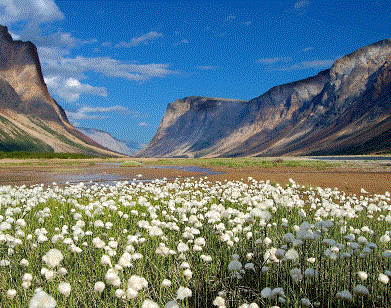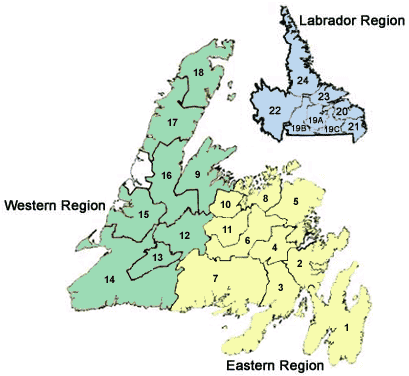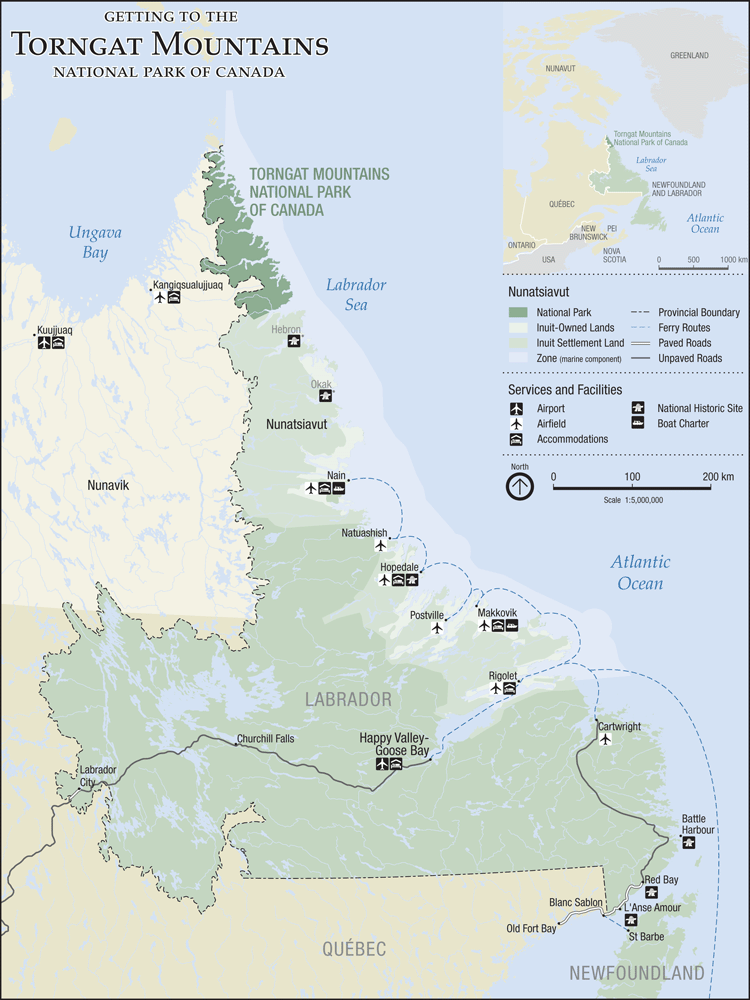Conservation Biology in the Boreal
HOW DOES NEWFOUNDLAND and LABRADOR COMPARE??
How Are Indigenous People Being INvolved Here?
You're probably wondering by now, what is Newfoundland and Labrador doing to incorporate our indigenous people into our conservation plans? Below you will find two of the most well-known cases where indigenous people have collaborated with researchers.
Forestry Management
Location of the Torngat Mountain National Park in Labrador (click image to see a larger, more detailed map)
Source: http://www.pc.gc.ca
An Inukshuk in Torngat Mountains National Park.
Source: http://www.pc.gc.ca
Torngat Mountains National Park
Forest management districts within Newfoundland and Labrador (click the image to see a larger, more detailed map). Source: http://www.nr.gov.nl.ca
To start off, below is an informative video highlighting how science and traditional Inuit knowledge have merged together in the Torngat Mountains National Park.
Torngat Mountains.Source:http://www.pc.gc.ca
Inuit explaining their common walking and nature trails throughout Torngat Mountains National Park.
Source:http://www.pc.gc.ca/
Timber harvesting.
Source: http://www.nr.gov.nl.ca
It is clear that Newfoundland and Labrador is headed in the right direction towards co-management with the indigenous people of the province, but we still have a long way to go if we want to be on par with Canada and the rest of the world. There are still many areas not co-managed within the province and there are infinite strategies out there that we can utilize to benefit our conservation strategies and build lasting, trusting relationships.
Torngat Mountains National Park (TMNP) is the third national park in the province and the first in Labrador. Not easily accessible, it is located in the most northern part of the province in Nunatsiavut (see map below) and although there are no direct inhabitants of the park, Inuit communities surround it. Establishing the park was a new concept since it revolutionized how we create national parks with regards to involving indigenous people and a true partnership was established between Parks Canada, the Labrador Inuit Association and the Government of Newfoundland and Labrador. TMNP is protected by the constitutional land claims agreement (13).
The creation of the park is supported by Nunavik Inuit and Labrador Inuit since they agree conservation measures are necessary to protect their sacred lands. An excellent quote from John Jararuse, an Inuk from Saglek, says “The park will help us protect our land and our memories and our stories”. Its establishment, operation, and management is a co-operative movement recognizing the indigenous people as partners, instead of employees (13). This was an issue in the very beginning of the park planning since original plans did not indicate a relationship with the Labrador Inuit Association; they filed a claim to insure any discussion of park establishment included a land claim negotiation (14).
The Park Impacts and Benefits Agreements is composed of seven members appointed by Parks Canada, Makivik Corporations and the Nunatsiavut Government; they advise the federal Minister of Environment on matters directly related to TMNP (13). By recognizing Inuit knowledge and incorporating it into the advisory team, it given the indigenous people as sense of empowerment and ownership (14).
TMNP is a great success story for Canada and highlights how we must continuously build relationships with the indigenous people through “…trust, mutual respect, and a deep understanding of Labrador Inuit values and tradtions.” (13). However, given that the province of Newfoundland and Labrador were not directly involved in making this co-management happen, the credit for this success story must go to Parks Canada (a federal organization).
Forest Management District (FMD) 19 is located in Goose Bay, Labrador. It involves forest ecosystem management planning based on input received during public meetings. In 2001, the Province of Newfoundland and Labrador and the Innu Nation signed an agreement based on the unsettled Innu land claim for FMD19 (15). The agreement allowed for the Innu Nation to have full participation in the planning, management, designing, and ongoing operations within FMD 19. In addition to co-management, any developments within the areas would provide direct economic benefits that a sustainable forest industry can provide to the Innu (16).
This caused the creation of a Forest Ecosystem Strategy Plan for Forest Management District 19 that is intended as a five year plan. It focuses on sustainable development and ecosystem management (15). Part of this is an ecological Protect Area Network (PAN) designed to maintain the landscape, watershed, and stand within FMD19 (14).
At the individual levels, the objective is to create conservation zones and reserves encompassing major habitats as well as maintaining “corridors” between them. Also ,at the landscape level is the cultural protected area network which work to protect the values, resources, tourism, and heritage of the indigenous people in FMD19 (15). Overall, the agreement helped fortify government-Innu relationships and allows both parties to benefit from any development in FMD19.





